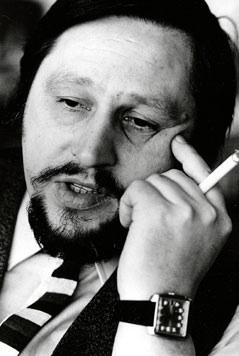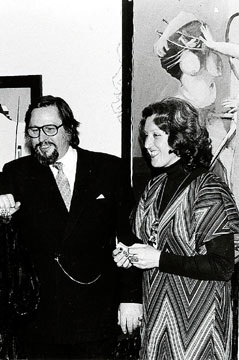
INTRODUCTION
Notes for the user
BIOGRAPHY
CATALOGUE RAISONNÉ
Oil on Canvas
- by year
- by category
Work on Paper
- by category
EXHIBITIONS
Solo exhibitions
Group exhibitions
REFERENCES
Life & Work
Commission works
Catalogues & Journals
Newspaper articles
ABOUT
IMPRINT
SEARCH
PICTURE INQUIRY
 One can consistently hear the following words by Alfred Kornberger's colleagues who attended the Viennese Academy of Fine Arts together with him, »Kornberger had what it takes to make an international carrier as a painter«. This shows the ungrudging acknowledgement of his talent, which soon made him excel amongst other artist colleagues.
One can consistently hear the following words by Alfred Kornberger's colleagues who attended the Viennese Academy of Fine Arts together with him, »Kornberger had what it takes to make an international carrier as a painter«. This shows the ungrudging acknowledgement of his talent, which soon made him excel amongst other artist colleagues.
On the other hand, it has to be concluded that Kornberger did not at the end succeed in establishing himself as an artist. In fact, Kornberger is one of the artists who have not been granted exhibitions by any larger museum in their lifetime and who have not been in the focus of the art world.
The publication of the first major monograph to be released was financed by Kornberger himself. At the same time Kornberger created an incredible number of paintings in his lifetime and literally worked around-the-clock at his large studio in the Viennese district of Währing. Still, the tremendous number of his works and the stunning quality of his pictures was not noticed enough in his lifetime. Indeed, Kornberger is both a hidden talent as well as an insider tip among connoisseurs, still to be discovered in Austria's post 1945 artistic landscape.
»I tried to give sense to my life; I tried to do something called art. « Alfred Kornberger, September 30, 1996
Alfred Kornberger - The nude as innovation
Alfred Kornberger was born in Vienna in 1933. His art belongs to the Austrian tradition of depicting the human body that spans from Egon Schiele to Alfred Hrdlicka.
From about 1970 onwards, Kornberger turned his attention completely towards the female nude. In his studio in the Viennese district of Währing nude models were constantly working for the painter, but also for many of his students. The focal point of Kornberger's life was his spacious studio that can be compared somewhat to what the studio meant for British painter Francis Bacon. Kornberger's studio was a place of convivial artist festivals where, besides painter-colleagues, regularly writers and musicians got together as well.
When he was young, Alfred Kornberger looked to the École de Paris stylistic orientation, particularly to the art of Braque and Picasso. Kornberger's early pictures are intensive efforts of coming to terms with Cubism and Surrealism. The artist was also preoccupied with subjects connected with technical progress, for example in his cycle depicting machines.
Parallels to his nude studies are to be found in the work of the group called the Naturalists, who in the 1960s and 1970s kept up the tradition of objective figural painting. The group included the sculptor Alfred Hrdlicka, as well as the painters Fritz Martinz and Hans Eisler. In a wider sense, Adolf Frohner may also be counted as one of members of this circle. Both the impressive studio pictures by Eisler, as well as Frohner's aesthetics of fragmented female torsi are reflected in the work of Kornberger.
Kornberger's almost obsessive preoccupation with the female nude reminds one of the great Austrian painter and graphic artist Egon Schiele. Like Schiele, Kornberger varied his view of the female nude from the male perspective. The eroticism of desire constantly plays a central role, as does the gaze of the voyeur. Kornberger presents his models both in ecstatic contortions and in stylish elegance.
Kornberger also gave regular private painting and drawing lessons and his studio was frequently the place for many social events and exhibitions, which were always popular among his colleagues.
Kornberger's late works, dating from the 1990s, advance towards a distinctly painterly, four-colour design, combining not only elements from Expressionism, but also the influence of the so called Fauves (French for »wild beasts«). Kornberger can definitely be considered as one of the great colourists of the late 20th century. Colour plays a central role in his work as an emotional factor of expression.
As a consequence of a serious illness lasting many years, Alfred Kornberger died in Vienna 2002, at the young age of 69.
from Franz Smola, »Alfred Kornberger (1933-2002). The Nude as Innovation«, Vienna 2007.
Short Biography
1933
Alfred Kornberger was born on July 3 in Vienna. He descended from a bourgeois suburban working class environment.
1947 - 51
Apprenticeship as lithographer in a Viennese printing shop. Then Kornberger works as Lithographer.
Because of the family's moderate financial situation Kornberger gained a solid profession, and although his artistic talent was soon to be discovered, he didn't think of the possibility of attending an art academy.
1949
During his apprenticeship Kornberger took evening courses in painting and anatomy at the Viennese Volkshochschule (Adult Education Center) directed by Gerda Matejka-Felden. As soon as 1951 Kornberger's first group show was organized in the Messepalast, Vienna (together with students of the Volkshochschule, a. o. Otto Mühl).
1952 - 56
Studied Painting at the Academy of Fine Arts, Vienna. (Master class Robin Christian Andersen). Andersen's teaching was based on objective drawing (still lives, nudes with coal and later gouache).
At the beginning Kornberger finances his studies by occasional jobs and later also by scholarships a. o. from the Austrian Ministry of Education, the Arbeiterkammer Österreich (the Chamber of labour) and the City of Vienna.
1956 he graduates and is honoured with the Golden Füger-Medal.
from 1953
Journeys to Germany, the Netherlands, Sweden, Denmark, South France and to other European countries.
1956
Journey to the Netherlands with stops in Amsterdam and Hamburg.
1957 - 58
Kornberger receives an UNESCO-scholarship for a one-year study in Bangkok, Thailand (former Siam), where he executed a cycle about Siam.
1958 - 70
Kornberger lives and works in his studio in Währingerstraße 91, in the 18th Viennese district.
from 1958 - ca. 75
Besides his artistic activity Kornberger works as commercial graphic designer for several companies in Vienna, predominately for the steel company Simmering-Graz-Pauker-AG, the construction company Rigips-Ges.m.H. and the Scandinavian Airlines SAS.
1960
Alfred Kornberger marries Nevenka Vavra.
1960 - 61
Kornberger executes Cubist and Surrealist works  1960-70
1960-70
Kornberger does a lot of commissioned works for Kunst am Bau. He creates huge glass mosaics and sgraffiti on residential and public buildings in Vienna and Lower Austria.
1966 - 68
Kornberger focuses on the motif of the machine in motion (simple constructions, spur-gears, rotary disks, cranks, rods,...)
1969-70
A commissioned work by the Oesterreichisch-Alpine Montangesellschaft should represent their factories. Kornberger executes several industrial pictures in water colour.
Kornberger contributes an essay to the students' magazine of the Montanistische Hochschule Leoben, »Die Industrie - Gegenstand künstlerischer Auseinandersetzung«. This article is one of the most important sources of Kornberger's personal statements about his artistic work.
from 1970
Kornberger encompasses from the conventional gallery- and exhibition scene. Smaller galleries in rural areas and more unconventional exhibition locations such as butcher shops, pastry shops, and branche banks are predominately his preferred exhibition spaces. At the same time Kornberger is very productive in his studio and focuses the female nude.
1971
Son Christian is born. The family moves to Währingerstraße 162, 1180 Vienna; and the former studio, where they lived and he worked from now in just serves as a studio. Kornberger delves into professional nude models and deals intensively with the female nude.
There are a lot of waving figures in this work period.
1974 - 76
Kornberger often deals with bathing scenes on the beach.
1975
As a result of regular visits of Kornberger and his family of his relatives in the Waldviertel, Kornberger works on several sceneries. Additionally he executes some water colour-works inspired by his journey to Krk, Croatia.
1976
Drawings of nudes with motifs from the gym hall and female nudes in armchairs. From 1976 to 77 Kornberger executes stripping ladies and butcher-motifs. Since 1976 Kornberger has been dealing with the film the medium.
1977
Kornberger creates a cycle of transportable nudes, so called »Schablonenakte (model nudes) «, which are exhibited at the Galerie am Bauernhof, Anzing. This cycle is a synthesis of the media picture and sculpture. The first of several "Zeus" - cycles occurs. Zeus, the highest of the Olympic gods, and notorious for his love adventures, is transformed into the motif of a bicycle and becomes the attacker of women.
1979
Kornberger is a member of the »Vereinigung bildender Künstler Wiens« - a membership of the Künstlerhaus in Vienna, which opens up to him further occasions for exhibitions.
1980
Alfred Kornberger organizes public painting and drawing courses for amateurs and advanced learners.
from 1982
Motifs from the artist's studio occur.
1983
A second cycle of »Zeus bedrängt eine Frau (Zeus pestering a lady) « is created.
1985
Kornberger is awarded the professional title »Professor«. The second half of the 1980s is affected by an unusual activity of Kornberger for exhibitions.
1986 The »Moulin Rouge« cycle is inspired by body and motion, which Kornberger finds at the Viennese nightlife, at the cabaret, from dancers and strippers. Kornberger likes extraordinary exhibition situations. In his exhibition at Währinger Park, which he organized due to the inauguration of soldiers in a tent of the Federal Armed Forces, Kornberger condemns the war and every form of violence
The »Moulin Rouge« cycle is inspired by body and motion, which Kornberger finds at the Viennese nightlife, at the cabaret, from dancers and strippers. Kornberger likes extraordinary exhibition situations. In his exhibition at Währinger Park, which he organized due to the inauguration of soldiers in a tent of the Federal Armed Forces, Kornberger condemns the war and every form of violence
In the cycle of Venice Kornberger shows topographical views of the city after visit of the city.
1987
Insects and spiders act increasingly as motifs.
1989
The cycle »Affe und Frau (Monkey and woman) « is executed. According to Kornberger himself the cycle is a reversion of the erotical cycle of »Zeus«, in which now the woman becomes the active part.
1990
The cycle»Neid und Haß (Envy and Hate)« after the Apocalypse of St. John consists of ten oil paintings. Since 1960 Kornberger has been dealing with the topic several times.
In the last decade of his life Kornberger suffers from a serious illness.
1991
Kornberger's first monograph, »Alfred Kornberger. Bilder und Graphiken aus den Jahren 1974 - 1990« is published by the artist.
from 1995
Kornberger deals with the subject of mentally ill figures.
from 1996
Motifs of a slaughterhouse appear.
2001
Due to his illness Alfred Kornberger has to stop the production of oil painings. He is henceforth devoted to lithographs of his earlier drawings, which he mostly paints in watercolours or felt pens.
2002
Alfred Kornberger dies in the age of 69 on March 31 in Vienna. On his deathbed he gestures his last picture before his mind's eye.
 previous
previous